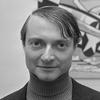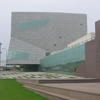More about Artist’s Studio No. 1 (Look Mickey)

Sr. Contributor
Roy Lichtenstein utilized the collective masterpieces of art history the way most painters use colors on a palette.
To Lichtenstein, the history of art was an open source inspiration to pick apart and remold. Decades into his career, even his own masterpieces found their way into his mise en abyme reflections. But instead of sticking to one painting within a painting, he’d build a composition from several pieces, like putting together a puzzle or gathering blooms for a flower arrangement.
All that to say, Artist Studio No. 1 (Look Mickey) isn’t so much an idealized glimpse of his workspace, as the title of the series might suggest, as it is an imaginary studio constructed of his art and a few homages to his favorite painters.
The most obvious borrowed element is, of course, part of his composition from his own painting two decades earlier called Look Mickey, a piece he referred to as his first Pop painting. In this piece he transplants enough to leave no ambiguity as to what Donald Duck has hooked, but you can’t see Mickey laughing at his friend just outside the frame. The original painting was based on an illustration in a 1960 children’s book titled Donald Duck: Lost and Found. In the book, as Mickey is laughing he tells Donald, “Land it and you can have it fried for lunch.”
The rest of the borrowed art is more subtle, but there's more of it than you might expect. As this series was directly inspired by Henri Matisse’s paintings from 1911, Red Studio, and Pink Studio, there’s a couple shout outs to him. More direct appropriations from Matisse pop up in several other paintings from the Artist Studio series. In this one you’ll find the pewter jug from, well, The Pewter Jug, tucked behind the couch, alongside some bright foliage and a few fruits plucked from Matisse’s still lifes.
The plant is also inspired by Matisse, but could be based on a bit of greenery from a number of interior pieces featuring plant life - potentially Corner of the Artist’s Studio painted in 1912. But Matisse isn’t the only featured bit of inspiration. Nestled beneath Look Mickey you’ll find a slice of Fernand Léger’s The Baluster.
At the top of the piece you’ll find a fragment from Lichtenstein’s Entablatures series - an entablature being an architectural element such as a horizontal band or molding running along the top of a building supported by columns - basically a decorative feature of classic Greek architecture. For Lichtenstein’s series he stacked a bunch of different entablatures together to fill a composition. So he borrowed one to spice up the ceiling of this studio.
Just before he created his Entablatures series, Lichtenstein did a series of Mirror paintings which also found its way into this piece. His abstract rendition of reflections made up of Ben-Day dots from a comic art style being the most trademark element in the mirror found in this studio.
To round up the Where’s Waldo hunt of his featured career, the yellow phone comes from R-R-R-Ring!!. The canvas frame in the corner behind said phone is from his Stretcher Frame series. Maybe you’re sensing the theme here. The couch is from a piece called Couch. The landscape painting on the wall is reminiscent of Landscape with Clouds.
Conversely, the door was flipped over and reused in Knock, Knock, which he made three years after Artist Studio No. 1 (Look Mickey). The side table the phone is perched on found its way into Gold Fish Bowl, which he made five years after.
Since literally everything in this painting came from or went elsewhere after, art-wise, you might expect the framed quote in the center of the piece to have some outside significance. Lichtenstein often liked to incorporate quotes in his work, particularly in comic speech bubbles such as this. But, this quote is, as best as I’ve found, the only isolated element unique to this scavenger hunt of a masterpiece. The only potential connection is: in Roy Lichtenstein by Diane Walden, a text published by the Guggenheim museum, a “Curly Grogan” is mentioned in the special thanks section.
Sources
- “Artist's Studios 1973-74.” The Art Institute of Chicago. The Art Institute of Chicago. Accessed August 17, 2022. https://archive.artic.edu/lichtenstein/themes/Artists-Studios.
- Bernardo, Mark P. Lichtenstein in New York: A Pop Art Life. Berkeley, CA: Roaring Forties Press, 2017.
- Branigan, Edward. Tracking Color in Cinema and Art: Philosophy and Aesthetics. S.l.: Routledge, 2020.
- Buettner, Carl, Bob Grant, and Bob Totten. Walt Disney's Donald Duck, Lost and Found. New York: Golden Press, 1960.
- Collins, Jim. Architecture of Excess: Cultural Life in the Information Age. New York: Routledge, 1995.
- “Corner of the Artist's Studio, 1912, 114×192 Cm by Henri Matisse: History, Analysis & Facts.” Arthive. Accessed August 17, 2022. https://arthive.com/henrimatisse/works/366708~Corner_of_the_Artists_Stu….
- “Knock, Knock Poster.” National Gallery of Art. Accessed August 17, 2022. https://www.nga.gov/collection/art-object-page.76446.html.
- Lanchner, Carolyn. Roy Lichtenstein. New York: Museum of Modern Art, 2009. (pg. 26-31)
- “Look Mickey.” National Gallery of Art. National Gallery of Art. Accessed August 17, 2022. https://www.nga.gov/collection/highlights/lichtenstein-look-mickey.html.
- “Roy Lichtenstein. Landscape with Clouds. 1964.” The Museum of Modern Art. Accessed August 17, 2022. https://www.moma.org/collection/works/38603.
- “Roy Lichtenstein.” Paula Cooper Gallery. Accessed August 17, 2022. https://www.paulacoopergallery.com/exhibitions/roy-lichtenstein#tab:sli….
- “Roy Lichtenstein: Gold Fish Bowl.” Whitney Museum of American Art. Accessed August 17, 2022. https://whitney.org/collection/works/349.
- Waldman, Diane. Roy Lichtenstein. Guggenheim Museum, 1993.
Featured Content
Here is what Wikipedia says about Artist's Studio—Look Mickey
Artist's Studio—Look Mickey (sometimes Artist's Studio, Look Mickey, Artist's Studio – Look Mickey or Artist's Studio No. 1 (Look Mickey)) is a 1973 painting by Roy Lichtenstein. It is one of five large-scale studio interior paintings in a series. The series is either referred to as the Artist's Studio series or more colloquially as the Studios and sometimes is described as excluding the other 1973 painting, reducing the series to four.
The series refers to a set of works by Henri Matisse, with this work specifically referring to L'Atelier Rouge. The work incorporates several other Lichtenstein works and gets its name from the large portion of Lichtenstein's Look Mickey that is included. Lichtenstein used a much more realistic representation of his own works than is standard for most artists. Elements of the work also refer to works from both Fernand Léger and Matisse.
Check out the full Wikipedia article about Artist's Studio—Look Mickey












